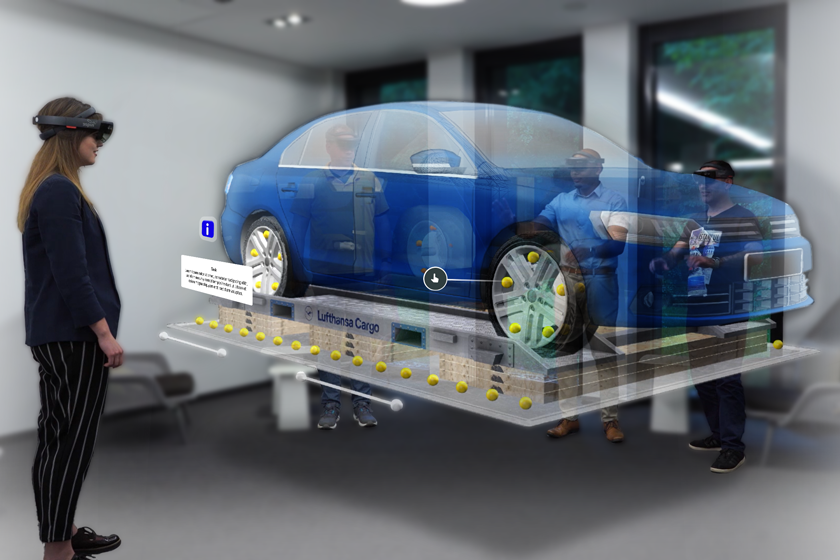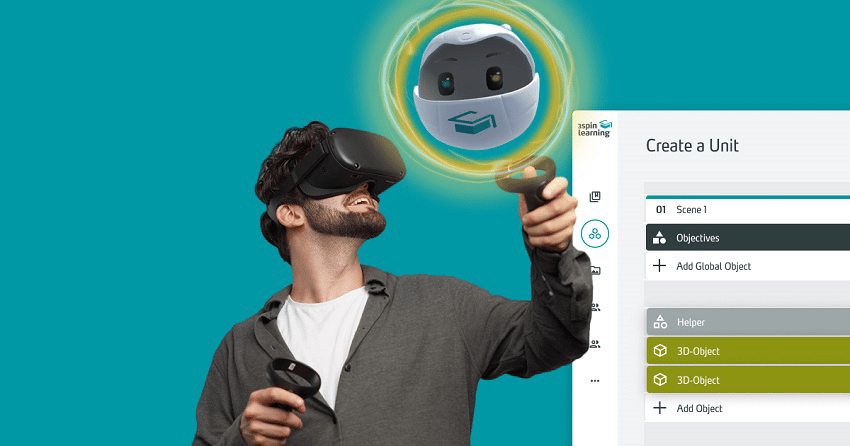XR Technologies on the Rise: Benefits for LearnChamp Customers
Im Interview mit dem Geschäftsführer von LearnChamp, Michael Repnik, erfahren Sie, was die Künstliche Intelligenz für das Lernen im Corporate...
Discover the benefits of VR/AR & KI training and Learning 3.0 and the future of immersive learning in an interview with learning expert Torsten Fell.
VR training environments make learning content visible that is not easy to convey in the real world. Organizations can realistically depict dangerous situations, complex processes, and resources that are difficult to access, visualize the invisible, or depict situations, products, and processes that could only be represented in reality with considerable effort. This significantly improves the learning experience for employees.
The ability to immerse yourself in an immersive 3D environment and interact with other participants and objects in real-time opens up new horizons in the field of learning. In this fascinating world of immersive learning, Virtual and Augmented Reality take centre stage and we are convinced that they will shape the future of learning.
In an interview with Torsten Fell, an expert in the field of immersive learning and founder of the Institute For Immersive Learning, he discusses the possibilities of VR and AR in the education sector, explains why the detailed reproduction of the real world is not the decisive factor and how companies can successfully implement these technologies.
TF: The technology creates a virtual space where I can become part of a group in an immersive 3D environment and interact with it – without a mouse click or keyboard. Users move motorized like in the real world and communicate with other participants and objects in real-time. This social presence and collaboration in a virtual environment enables joint creation, editing, and creativity.
With this in mind, companies can use a VR environment to present access to situations, hard-to-access resources, new products and processes, and much more that would be difficult or impossible in the real world. Learning content can also be presented that is not yet real at the time, e.g. new products and processes. The understanding of spatial relationships can also be made tangible. I call this the X Factor when the VR world can do more than the real world. VR and AR make things visible that we don't see in real life. Furthermore, users have the opportunity, for example, to slip into different roles that they would not be able to experience in the real world or that would require much effort.
VR and AR help visualize elements that we cannot see in real life.
Visualizing learning content and situations in the virtual world provides immense added value compared to reality. Companies can also track and analyze valuable data in the VR world using eye tracking, for example. Learning analytics is already widely used in the USA and is generating new topics.
Aligning with business objectives and focusing on target groups and learning orientation are helping here.

TF: Of course, a VR environment reproduces the real world on a virtual level, but in my opinion this is not the most important aspect of virtual reality learning. Rather, the great advantage lies in making the invisible visible and experiencing and exchanging this with others. One example would be the visually detailed visualisation of gases and liquids at a molecular level or the blood plasma particles in the human organism. In my opinion, the collaborative exchange of ideas significantly promotes learning success and sustainability.
The 3D world as an environment also plays a role: we humans live in a spatial world, but learn and work on computers and smartphones in the 2D world. Why should we limit ourselves to the 2D surface? When a virtual spatial environment and the expansion of real space through virtual objects can offer us so much added value?
TF: At the moment, I see a drawback in the limited distribution of VR glasses and, in some cases, prejudices and misunderstandings that have grown over the years. VR and AR are not something that can be explained, they have to be tried out and experienced. Users have to put on their VR glasses and immerse themselves in the virtual environment in order to understand the possibilities of this technology. This requires a certain amount of time to sensitize them. Many situations in the AR environment need to be experienced to understand the possibilities and limitations.
The attempt to transfer methods and procedures from the real world 1:1 to the virtual world is another point; transformation work must be carried out here and the new possibilities of the virtual world must be understood and rethought.
Many people believe the myth that 3D is complex, complicated, and expensive. The feeling for VR and AR is still missing in some cases. 3D is hardly known in many parts of the organization. Now we're coming up with a medium and content that they're hardly familiar with at all, and I believe that the trainers have a lot of respect for the new skills in the 3D environment. At least this is my experience from six years of empowering VR/AR trainers and VR Collaboration Experst training.
TF: German HR developers and learning experts have been constantly introducing new technologies in recent years, from WBT authoring systems and e-tests to LMS systems, LXP experience platforms and video formats, and so on. Understandably, there are initial concerns about yet another technological innovation. As none of these can depict spatiality in the virtual world, this can only be used as a comparison to a very limited extent.
Every company should ask itself an important question: What is the alternative to communicating my business goals sustainably and efficiently? The alternative would be much more expensive and much less efficient.
For example, in face-to-face training on a forklift truck, ten out of twelve learners see nothing at all if they are not standing in front of the trainer. In addition, classroom training usually only takes place at one location, and scaling up quickly becomes time-consuming and expensive. In our example, forklift trucks would have to be taken out of the plant for the training sessions, skilled workers would have to travel to the training sessions, not to mention maintenance and support. If companies buy VR/AR glasses here, it certainly sounds like a lot of money for budget planning at first, but in the long term, the costs are cheaper than having to hold up the entire production several times a year at different locations and having employees travel from different cities. It's also better for the environment.
Most organizations seek scalable solutions that generate added value compared to face-to-face events. One solution here is intelligent blended learning constructs in which face-to-face and VR/AR training courses are interlinked. This requires a sensible change concept including target definitions and the definition of data protection guidelines. This is where good consulting comes into play, which is orientated towards the individual use case and finds the right solution.
TF: Very often, companies have already decided in favor of a certain tool or technology without being aware of the respective use case. Unfortunately, this is a big mistake. The clear objective, the learning objectives, the target groups, and the framework conditions should be looked at more closely beforehand. This is followed by an independent search for a technical solution.
I would recommend that organizations start with a VR/AR Experience Day, where managers can learn about the benefits and disadvantages of VR/AR and 360-degree training and try them out live. The range of immersive technologies is very broad.
Only then does it make sense to talk about the business objectives and select the technology and corresponding software. These experiences support the efficient and sustainable realization of specific objectives.
TF: We are still in the early stages of using artificial intelligence, but no company will do without it in the future. We have seen the beginning at text and image level. There has also been hand tracking, face tracking, eye tracking, and much more in the VR/AR environment for years. Now new areas of artificial intelligence are being added.

Object creation and collaboration with AI-based avatars will be a major topic. These can be used to conduct interactive dialogues, which offer a major advantage over traditional eLearning with supported decision trees. Learning content can also be changed visually and functionally during operation with the help of AI.
It is important to clearly and comprehensibly label content and AI-controlled avatars to remove any ethical concerns.
As we can see, the topic of 3D hovers over everything, and we as providers must not underestimate this and need to do some convincing. Companies need standard solutions to prepare customized content. In the past, this was often expensive and time-consuming and many companies wondered whether the expense was justified.
Thank you very much for this interesting interview Mr. Fell!

Torsten Fell is a renowned expert in the field of immersive learning (VR, AR, MR), corporate learning and business transformation.His passion for shaping the future drives him and he is convinced that openness to diverse perspectives and a willingness to change are crucial to create a promising future.
With an impressive experience of over 25 years and an impressive track record of more than 100 successful projects, he has made a name for himself as a source of inspiration, sought-after speaker, consultant and author.

Im Interview mit dem Geschäftsführer von LearnChamp, Michael Repnik, erfahren Sie, was die Künstliche Intelligenz für das Lernen im Corporate...
Learn how Virtual Reality takes leadership training to a new level and strengthens soft skills in an interview with digital learning agency vr-train.
Discover how 3spin Learning's innovative VR features empower organizations to create immersive training courses without coding.
Stay up to date on new insights in VR / AR learning with AI and build or improve your knowledge within the technology.